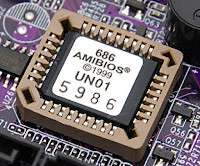
BIOS (Basic Input/Output System) is a set of computer instructions in firmware that control input and output operations.
BIOS is an integral part of your computer and comes with it when you bring it home. (In contrast, the operating system can either be pre-installed by the manufacturer or vendor or installed by the user.) BIOS is a program that is made accessible to the microprocessor on an erasable programmable read-only memory (EPROM) chip. When you turn on your computer, the microprocessor passes control to the BIOS program, which is always located at the same place on EPROM.
When BIOS boots up (starts up) your computer, it first determines whether all of the attachments are in place and operational and then it loads the operating system (or key parts of it) into your computer's random access memory (RAM) from your hard disk or diskette drive.
With BIOS, your operating system and its applications are freed from having to understand exact details (such as hardware addresses) about the attached input/output devices. When device details change, only the BIOS program needs to be changed. Sometimes this change can be made during your system setup. In any case, neither your operating system or any applications you use need to be changed.
Although BIOS is theoretically always the intermediary between the microprocessor and I/O device control information and data flow, in some cases, BIOS can arrange for data to flow directly to memory from devices (such as video cards) that require faster data flow to be effective.
វគ្គក្រោយនឹងមានបកប្រែជាភាសាខ្មែរ....
វគ្គក្រោយនឹងមានបកប្រែជាភាសាខ្មែរ....

















No comments: